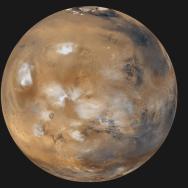New findings from NASA’s Mars rover Curiosity could provide an answer to the mystery of what happened to the planet’s ancient atmosphere and how Mars has evolved over time.
Researchers have long believed that Mars once had a thick, carbon dioxide-rich atmosphere and liquid water on the planet’s surface. That carbon dioxide and water should have reacted with Martian rocks to create carbonate minerals. Until now, though, rover missions and near infrared spectroscopy analysis from Mars-orbiting satellites haven’t found the amounts of carbonate on the planet’s surface predicted by this theory.
In a paper to be published April 18 in Science, data from three of Curiosity’s drill sites revealed the presence of siderite, an iron carbonate mineral, within the sulfate-rich rocky layers of Mount Sharp in Mars’ Gale Crater.
The discovery of this mineral in rocks close to the surface suggests that there was in fact an ancient Martian atmosphere, which contained enough carbon dioxide to be warm enough to support liquid water existing on the planet’s surface.
Though scientists have suspected Mars once had a much more substantial carbon dioxide atmosphere, this is the first time they’ve found mineral evidence.
"Earth's surface has been continuously habitable since about 3.5 billion years ago, but Mars's surface evolved from more habitable early on, to uninhabitable today,” said Edwin Kite, associate professor of geophysical sciences at the University of Chicago and third author on the paper. “This discovery helps us understand the mechanisms that drove the two planets down very different paths."
Drilling down
NASA’s Curiosity rover landed on Mars in 2012 and has been exploring the Red Planet ever since.
To study Mars’s chemical and mineral makeup, the Curiosity rover drills one to 1.5 inches down into the subsurface, then drops the powdered rock samples into an instrument in its belly called CheMin. The instrument, developed at NASA’s Ames Research Center in California’s Silicon Valley, uses X-ray diffraction to analyze rocks and soil.
“Drilling through the layered Martian surface is like going through a history book,” said Thomas Bristow, research scientist at NASA Ames and co-author of the paper. “Just a few centimeters down gives us a good idea of the minerals that formed at or close to the surface around 3.5 billion years ago.”
As Mars’ atmosphere thinned, the carbon dioxide it contained transformed into rock form. The new results suggest that carbonate may be masked by other minerals under the surface—which would have made it difficult to detect through other previous methods, such as infrared satellite analysis.
In the future, missions or analyses of other sulfate-rich areas on Mars could confirm these findings and help us better understand the planet’s early history and how it transformed as its atmosphere was lost.
“The discovery of abundant siderite in the Gale Crater represents both a surprising and important breakthrough in our understanding of the geologic and atmospheric evolution of Mars,” said lead study author Assoc. Prof. Benjamin Tutolo of the University of Calgary.
Curiosity was built by NASA’s Jet Propulsion Laboratory, which is managed by Caltech in Pasadena, California. JPL leads the mission on behalf of NASA’s Science Mission Directorate in Washington.
For more information on Curiosity, visit NASA’s website.
Citation: “Carbonates identified by the Curiosity rover indicate a carbon cycle operated on ancient Mars.” Tutolo et al, Science, April 18, 2025.
Funding: NASA, Canadian Space Agency, Science and Technology Funding Council of the United Kingdom.
—Adapted from a news article first published by NASA.

